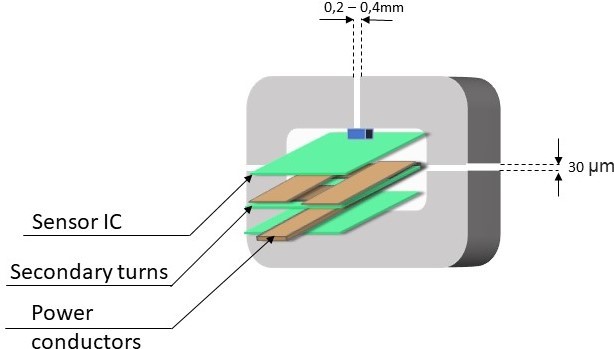Other Parts Discussed in Thread: DRV425, DRV401
Dear Mr. Javiers Contreras,
I hope you are doing fine in these times.
Project Description:
We at DC Opportunities R&D B.V in the Netherlands are developing a RCD (Residual Current Detector) for pure DC grids with ± 360 - 380 V DC mains voltage carrying a ± 10 A current which might vary depending on the load.
The RCD to be developed is to measure : ± 20 - 30 mA residual or leakage currents. Please find below an image for the idea of the RCD design:
Basically we are considering to place the PCB holding the DRV421 IC and it's circuitat the top just below a 0.4 mm air - gap which just sits on top of the sensor. Goal is to detect the flux (or fringing flux) jumping the air-gap along the sensor's sensitivity axis. The other 30 µm cuts are just for the purpose of adjusting the air - gap to 0.4 mm since the cut is usually 1 mm by the manufacturer of the magnetic core.
The second set of PCBs (~ 6 - 9 PCBs) will contain the secondary windings to provide the reqd. 200 - 300 mH for compensation as recommended in the datasheet.
The last PCB at the bottom consists of the Power Mains - 3 Cu Tracks on adjacent layer namely : +ve, -ve and Neutral ; the former two poles carrying ± 10 A load current respectively.
The goal is to sense any "differential" current (± 20 - 30 mA) or residual current flowing through these lines and immediately trip the faulty pole or set of poles. This is done by another PCB circuit consisting of a Solid State DC Circuit Breaker which has been built.
Magnetic Core: Core we are using is a Nanocrystalline material with relative permeability (µr) = 30,000 ( + slightly more for DC ). The core specifications are attached for your kind reference. I made some simulations for a 1 A differential current in COMSOL Multiphysics 5.3 as below:
Fig 1: Geometry used for 2D modeling of Nanocrystalline racetrack shaped magnetic core in COMSOL Multiphysics 5.3 b.
Fig 2: Simulation result with a 1 A differential current - Positive Cu trace carrying +11 A and Negative Cu track carrying -10 A respectively and 0A in Neutral.
We get - 360 - 410 µT/A on the "Probe" considered within the DRV421 PCB. The probe considered is 0.4 mm length and 0.3 mm height sitting within a 0.8 x 4 mm DRV421 sensor.
Below are my doubts and questions on the IC :
Questions:
1. What is the position of the 'Probe' (Fluxgate Front-end sensor) within the Fluxgate IC ? This is requested by us for an accurate simulation on COMSOL. An image representation of what I ask is below:
Fig 3: What is the length of probe 'X' and width 'Y' and it's position within the IC: 'X1 , Y1' .
2. What is the Relative Permeability (µr) of the fluxgate probe or the materia (Soft-iron/ Stell etc.) of the probe ? I ask this because even if the probe has a slightly higher permeability than air, the magnetic flux
density shoots up to 500 - 600 µT/A. Making it more sensitive to smaller current changes. Or do we need to consider a 500 µT/mA ?
3. When we talk about Fluxgate, does the core needs to be 'easily saturable' (around 200 - 500 mT) ? Or we talk about only the Fluxgate Probe which is easily saturated within the DRV421 ? The saturation of this
core we are using is around 1.5 - 1.7 T because of the material.
This question is related to the PCB layout for the Sensor:
4. There are around 38 VDD (3.3 V) and Ground vias on the top layer atleast with a distance of 3 - 11 mm from the DRV421 IC. An image is shown below:
Is it advisable to keep these many vias on the same layer as the DRV 421 , it being very sensitive to stray magnetic flux ? Also , there are Ground and Vdd (3.3 V) planes just below the top layer. Is this advisable also ? As the currents passing on the ground plane will have magnetic flux perpendicular to the DRV 421 (not along its sensitive axis) but the Vias might have flux along the sensing direction.
Should I preferably keep the vias as far as possible from the DRV IC ?
{ Note : The PCB is around 6.8 x 6.3 cms }
5. Do we need an external Degauss circuit ? Or the Demag option available within the IC would be perfect ? This is just a trial but idea is to extend the range of sensing to 100 - 200 A differential currents also later.
6. Just wished to know how the fluxgate exactly works within the sensor. Does the IC have an inbuilt PWM with Schmitt Trigger sending AC pulsating square waveforms or it is just a pulse like a hall effect sensor ?
Would be great to know atleast with a waveform and operation of the DRV. I have read the entire datasheet and application but the exact operation is not known to us. It would be helpful in further designs.
Atleast we would like to get the questions 1 - 3 cleared as we need to order the core earlier.
We have more doubts on the Schematics but I will post it if it is possible for you after your reply to prevent confusion. It is quite confidential but if any other email is available to address those specific questions I can send it there.
Thanking You,
Balaji Subramanian











